Freddy Gallery was a curatorial project located on Franklin Street in the West Downtown neighborhood. Curator/Painter/Blogger Josh Abelow sat down to talk about the project in October.
Every interview you’ve done so far has been under the Freddy moniker, right?
Yeah, everything I’ve said about Freddy in an online platform has been through the “voice” of freddy, but I also think by now most folks know it’s my thing. Well, I dunno, maybe there are plenty of people who have no idea? Anyway, I think it’s fine to say you’re interviewing Josh Abelow about it.
So, we’ve talked about this a little bit personally: what the aspect of anonymity offered that curatorial project. And what nuance levels there are to that? Because there’s a difference in maintaining a full cloak of obscurity so that maybe no one would know you and you wouldn’t show up at all.
I mean, as an idea, I really like the concept of complete anonymity.
What’s the name of the artist… God, I’m forgetting… Anyway, I’ll come back to it. Oh, Vern Blosum! So, the story is that there’s this AbEx guy who, in 1961, decided to make (invent?) Pop Art paintings under a false name as a kind of joke. The paintings look a lot like early John Baldessari (before Baldessari did them).
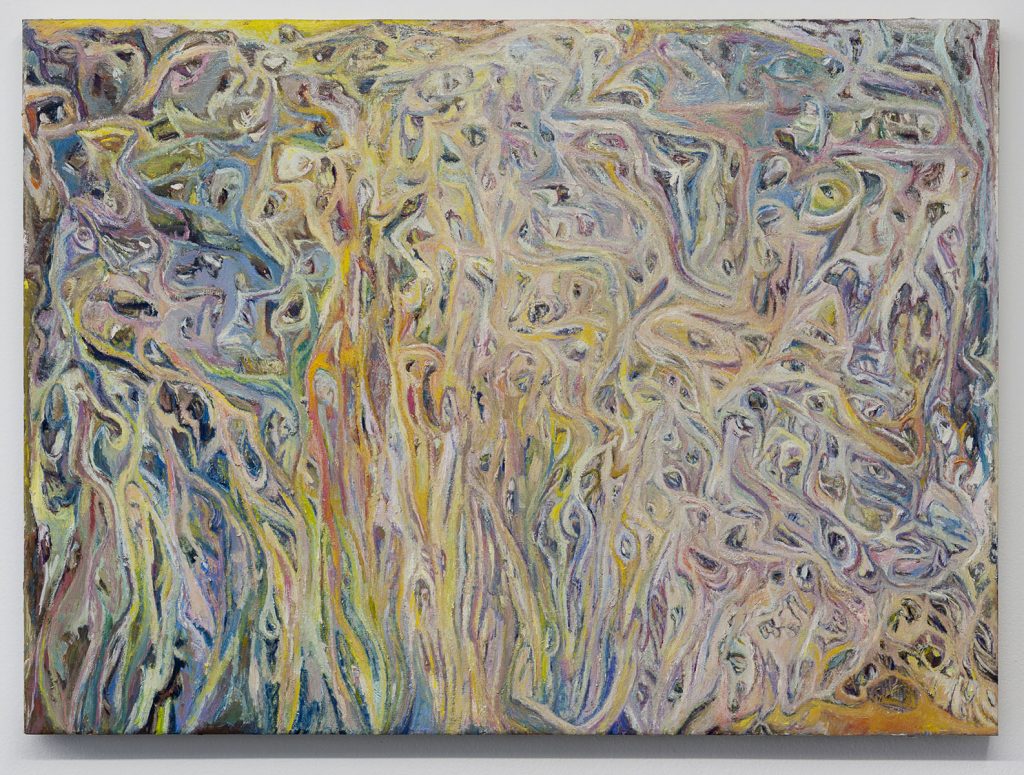
KEITH MAYERSON
Blosum was represented by Leo Castelli and I think MoMA bought one of the paintings and collectors were buying the work and what not. Basically, somebody got suspicious because there was no biographical information about Blosum and called the whole thing into question like, “This is fucking bullshit.” And after this artist going up and up and up, he just disappeared and all the works went into storage for 50 years. Maxwell Graham of Essex Street Gallery organized a show of these early works in 2013 and that was the first time I had ever heard the name Vern Blosum. In today’s world, where everyone knows everything about everyone because of social media, the concept of anonymity is especially attractive and interesting because it’s so rare.
All that being said, that level of commitment to anonymity was impossible for Freddy and it wasn’t really an objective—I was more interested in the idea of information about the gallery traveling around in the form of rumor—it was kind of inevitable that the cat would come out of the bag.
Right. Just the nature of gossip in smaller places.
Exactly.
It’s funny with that Blosum story. They’re all insincere works… is that the case?
I guess so. They’re satirical works, I would say.
Do you think that those works were valued for their attempts to fake it?
Well, I think they were valued because nobody had any idea that they were, essentially, joke paintings. To me, it seems like whoever made the paintings wanted to mess with the establishment through an act of infiltration.
—Yeah.
—And now, I think people are interested in the work and the idea of a fabricated identity because it relates to our relationship to the Internet and how we use Facebook or whatever to craft personas. There are so many artists who have careers based on playing pranks and that kind of thing. You know, Richard Prince’s joke paintings or Maurizio Cattelan hanging his entire Guggenheim show from the ceiling; I mean, there are so many examples. So, I think it’s an early example of that “pranking the art world as art” idea, which is very Dada.
***
Do you picture the Freddy character as the prankster then?
Yeah, I do.
When I got to grad school in 2006, I was so frustrated with this idea of the painter with a capital “P”—this person, alone in the studio, working on masterpieces with his or her big canvases and brushes. You know, like the romanticized idea of what it means to be painter.
So, I was fed up with this idea and I was trying to come up with different ways of staying committed to painting but, at the same time, I wanted to undermine it, critique or, to the best of my abilities, get out from underneath a purely narcissistic kind of practice.
I began to overproduce paintings as a form of defiance; Instead of focusing all my time on one large work, I would make like 60 or 70 or 80 small paintings and then I’d line them up in rows or grids like an assembly line. I was interested in a read of the work that would take into account this hyper-obsessive activity. All this led to an interest in doing my art blog, which, for me, was the antithesis of the lone painter in the studio.
Mmhm.
Freddy was sort of a segue into finding a middle ground between this Internet activity and getting back into having an actual space, talking to people, and dealing with objects. I was hoping that my blog viewership would bleed over into the Freddy audience, which I think it did.
***
With Peter Eide being the first Baltimore based artist that you showed, did that show have a difference in the way it came together than the shows that had happened previously?
I was excited to show Peter’s work because he was the first Baltimore artist. I had seen Peter’s work on Facebook probably a year before Freddy opened and I remember thinking, “This stuff is nuts, I really like this.” And I sort of put it on a shelf in the back of my mind and just let it be. When I got down to Baltimore, Jordan and I were talking and I was like, “Who should I go visit?”
He said I should go check out Peter Eide—and when I looked at his work on his website, I said, “Oh, this is the guy! I love this stuff.“ Jordan said, “Oh, you met him last night at the opening!” and I was like, “Oh shit, really?”
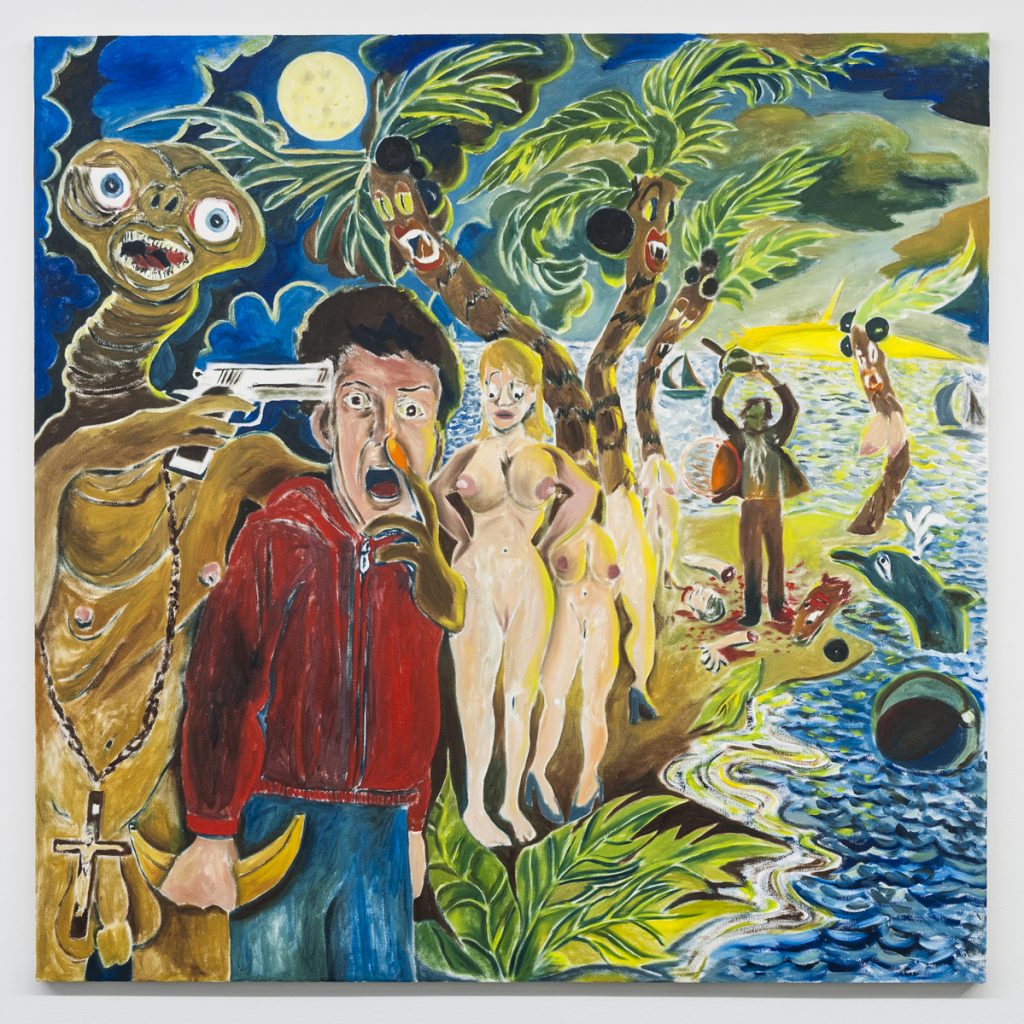
PETER EIDE
So, I went to Peter’s studio which is in a small town (New Windsor)—it’s actually the town where Clyfford Still used to live and work at the end of his career. It’s outside of the city, maybe like 45 minutes, kind of in the middle of nowhere next to a corn field.
I was intrigued by the whole thing because it was just fun to “discover” an artist working in relative obscurity in an old house, you know. He’s painting in his living room; there’s no proper studio. It all seemed very authentic.
And I was excited because Peter had never had a solo show in Baltimore despite the fact that he went to school here. So that was cool—to introduce the work to the local audience and also to a bigger audience via the Internet.
In the way that you talk about your own work (pushing against the solo artist myth, the painter alone in the studio), does it feel funny to lock on so much to Peter’s work when it is so framed in that myth? Like the way you just described it: “In the Clyfford Still town!”
Yeah! Yeah, totally. Curating allows me to fully embrace certain parts of my thinking that I wouldn’t do otherwise. To fully embrace Peter’s “Painter’s Painter” thing is so gratifying to me. And on the flip side, to work with Kenneth Goldsmith, who doesn’t make objects, is also extremely gratifying. Because that’s another side of my interests.
Did you feel like the curatorial impulse changed at all after there was criticism, like my writing or michael farley’s writing or that facebook conversation?
Yeah, I think so. When I came down here, I knew that there were four or five shows that I wanted to present. I wanted to work with Kenny Goldsmith, the Ross Bleckner dick show, William Crawford, I knew I wanted to do the Albert Mertz show. There were some very specific things I wanted to present in this context, but that wasn’t to say that I wasn’t interested in showing people who lived here; it’s just that up until 16 months ago, I wasn’t living in Maryland and my access to the scene was extremely limited. I knew a couple people in the community like Jordan, Steven Riddle, Seth and Alex. I had a kind of peripheral interest in Baltimore for quite a while but, also, I was an outsider. I didn’t know people well. So my intentions were to get down here, get the ball rolling, get to know people, and see what would come out of that. But, when Freddy started getting all that criticism pretty quickly, I made a conscious decision to speed up that process.
***
One of the questions I wanted to ask was just to touch on the gallery backing stuff, since there was gossip about backing from James Fuentes. How did that play out? What was the story with it, etc.
Well, first of all, talking about money is always weird, but—
—I only bring it up because, when I look at the art scene in Baltimore, so much of it depends on, “Where’s the space?” We just talked about the request for proposals on howard street, and how if something like that went through for any project around here, because of Baltimore’s size, possibly the entire trajectory for what people in town are making is altered. So it’s funny to see the way that real estate and money actually affect our creative output. So I don’t know—
—Yeah.
—It’s something I think about.
Yeah. In terms of the practical side of how the project came about, I had been following sophiajacob, specifically. They had invited me to participate in one of the lecture series events and I wasn’t able to do it, but I liked that they had reached out. I was following their program and I was posting their stuff on my blog. And at one point, near the end of their run, I was given an opportunity to co-curate a show in New York and I was interested in the possibility of including work by an artist from Baltimore. Which sort of goes back the fact that I’m from Maryland and I feel a connection to this city.
Also another part of it—I feel like, in New York, curators think they’re being adventurous if they show an artist who’s in NY, but didn’t go to Yale. Like if you don’t have an MFA from Yale, you’re a self-taught wacko or something. Like, “Whoa, you’re really thinking outside the box…” Anyway, I thought (and still think) that there’s talent in other pockets waiting to be discovered. And I thought (and still think) that Baltimore has a lot of creative energy. There are a lot of people making things that deserve attention.
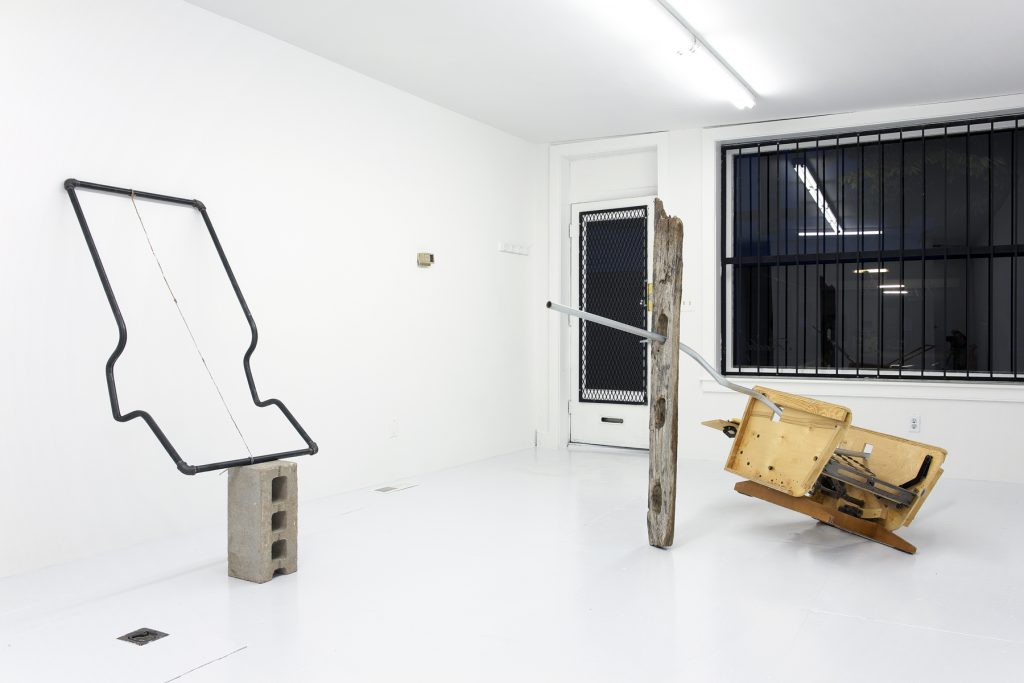
ROSY KEYSER
So, I did a couple studio visits down here. I met with Jordan and Steven and talked with them a good bit about all these kinds of thoughts. I didn’t end up including a Baltimore artist in the New York show for various reasons but, during that visit Jordan mentioned that the sophiajacob project would be ending soon. I said, “Whoa, really? What’s happening with the space? What is the rent?” Jordan said, “The rent is $300 and it’s gonna be available.” This price would never be possible in New York and, honestly, I was shocked. I’d struggled with the high cost of living in New York since I moved there in 1999. I find it extremely stressful and, in many ways, the antithesis of making art. Money is like a virus there; it just infects everything.
So, I sort of just made the decision to make this Freddy idea happen no matter what. I’m struggling to pay my rent, I don’t even have a proper studio, but I have to seize this moment. So I called my gallery in New York and said, “Hey, this is what’s up, are you interested? Would you want to partner with me or help me fund this and I’ll pay you back?” And at first he said yes and then he said no. Then he said yes again and we made it happen.
And the amazing thing I’ve learned is that, even though there’s cheap rent, the cost of doing this project is actually really expensive, and there’s no way we would’ve survived without the auction I organized with Paddle8—Freddy would’ve ended like 8 months ago. It was never about making money and it didn’t make money, but when all’s said and done I will hopefully break even. It was really just something I wanted to do and I figured out a way to do it.
Cool, that’s good to understand a clear picture of that.
Well, I think there’s an assumption that New Yorkers are rich—how else could they afford to live there? “That gallery or that artist must be making lots of money because they are in New York.” And having lived in New York for a long time, having practiced art for 20 years, having worked with more than one commercial gallery for more than five years, I can tell you that most artists and galleries (even the ones that are very visible) are not putting away stacks of cash. There’s a lot of smoke and mirrors in the art world.
If anything, I have this new level of respect for Lower East Side galleries that, you know, take risks. But even this last trip to New York, I noticed a lot of the spaces on the LES showing work that looked kind of safe, kind of salable, and what that signifies to me is exactly what I’m talking about. In order to stay afloat, these galleries are forced to show what the market wants. They do fluff shows so they can afford to stay in business. Then, hopefully, they can do a show with an artist who’s making more exciting, more interesting work who is maybe not so commercially viable.
***
How do you reflect on the project now that it’s done?
The project has been super refreshing in a lot of ways.
The fact that Freddy generated conversation, that it got a community of local artists (and maybe elsewhere) thinking and talking about these ideas is a good thing in my opinion. To be down here, to be part of a smaller scene, and also, sort of on a personal level, to see the tightness of the community has been inspiring. And it’s been great to be a part of it. Working with Jordan has been amazing, discovering June Culp’s work has been amazing. Peter, Stephen Booth—there’s so many interesting artists.
I have a young artist friend I was talking with the other day about how she’s so nervous about this show she has coming up in New York because, “if it bombs,” her career’s gonna be fucked and she’s not gonna be able to sell anything for the next five years and that kind of thing. And on one hand, there’s a side of me that’s like, “Ah God, don’t think like that. That’s horrible.” And then there’s another side of me that’s like, “God, you’re kind of right. It’s fucking very cut throat.” It’s a weird time to be a young artist, specifically in New York. I think it’s a bad time.
It’s very strange in New York—a particular artist might get some visibility in the scene and suddenly that person Has All These “New Friends.” It feels very disingenuous. In Baltimore, a lot of the artist friend groups and support seem to come from a more genuine place. And I have found that to be—I think that’s what I was looking for, that’s why I left. It’s kind of exceeded my expectations actually.
When you say, “Won’t be able to sell work for the next 5 years,” I think, “How can that not affect your output?”
Yeah. I think it’s crazy. I think it’s not a good place. I hate to sound like the Patti Smith lecture, like “Artists should leave New York! New York sucks!” but I feel very similarly to her. Have you ever watched that movie Downtown 81 with Jean-Michel Basquiat?
Yeah.
He goes down to the East Village and he goes to the Mudd Club and the LES looks raw and dangerous and fucked up. It was such a different scene and artists and musicians and creative minded people were all going there because it was fucking bombed out and it was cheap and there was an openness in terms of what was possible. It wasn’t about selling; no one imagined that they would be making money. Now, New York is just so sanitized; you can’t even walk down the street without seeing Citi Bikes everywhere. People could argue, “Well you know, that’s Manhattan but you still have the other four boroughs to explore.” But even that’s changing—I just read a big article in the Times about how Ridgewood, Queens (where I was living) is the new hip spot.
I sublet my apartment for a year and went back to move my things out when I decided I didn’t want to live there anymore and there was a new hip coffee shop right there on the corner next to my apartment. And it makes me depressed because there are generations of families that have lived in these neighborhoods that are gonna get pushed out. The rents are gonna go up and it’s just what it is.
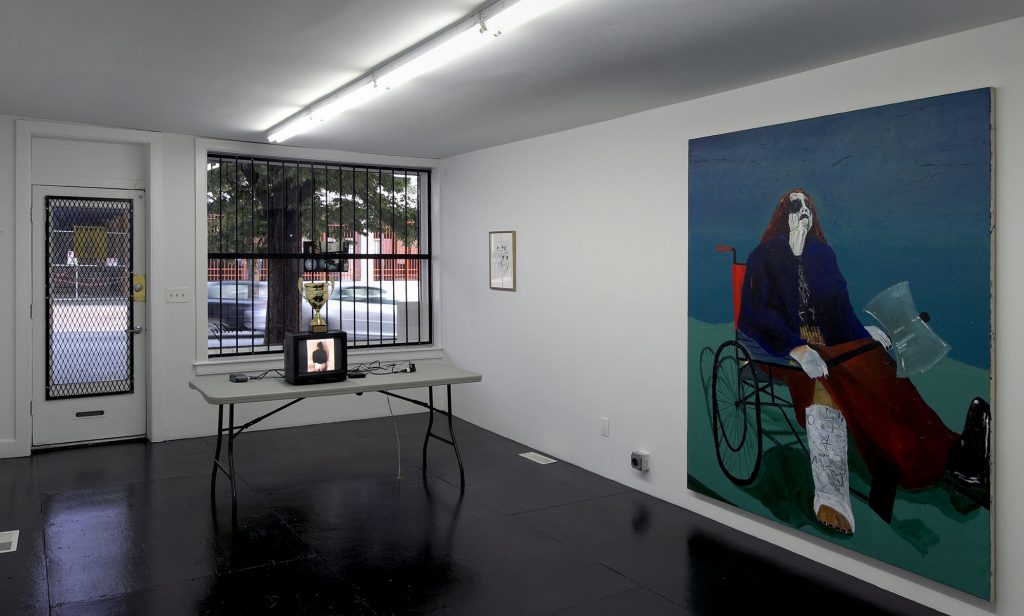
PHILIP HINGE, BRAD PHILLIPS, AARON CARPENTER
There’s just something great about being down here where there’re still warehouses that artists live in and weird noise shows at someone’s house. And people are doing it because they wanna do it and they believe in it and they’re doing it for their friends. And that’s the kind of stuff that made me want to be an artist.
Right, but I think people see the Ceremony Coffee shop pop up in Baltimore and everyone’s like, “Shit.” I feel that everyone here is super, super sensitive to any changes in that direction, because they’re like, “Well, this is it. Here it comes.”
Yeah, and I think, speaking to that, I can understand why people were freaked out about Freddy at first. Like does a New York based artist doing a project in Baltimore signify that the underground scene in Baltimore is gonna get fucked up?
I think that is part of the aspect in the question about the money— about people getting backed, various ways of “Testing Market Waters,” and seeing the Ceremony Coffee pop up, because, to an extent, that gossip stuff is real. I mean, I have some friends that, when they moved into their house a few years ago, went to the lease signing and the landlord said something like, “By the way, you’re going to be paying $50 more per month.”
They’re like, “What? You spring this on us after we’ve already agreed and are signing the lease?” And he just pulls out a flyer and says, “If these guys in Mt. Vernon are charging this much for a one bedroom, why can’t I?” Everyone is working on the same amount of information, it’s a weird social space to be in.
I’m also curious on your thoughts regarding the music scene as it relates to the art scene—like, in the last 10 years or so, there have been a number of bands coming out of Baltimore who have received national and international attention—I’m thinking of Beach House, Dan Deacon, and more recently Future Islands (among others). But it seems like with music, maybe if you’re in a cool band in Baltimore that the world doesn’t know about yet—do you think that folks want to blow up? Do they want the world’s attention? And, likewise, do you think young artists want to be engaged in a larger, more global dialogue—showing nationally and/or internationally?
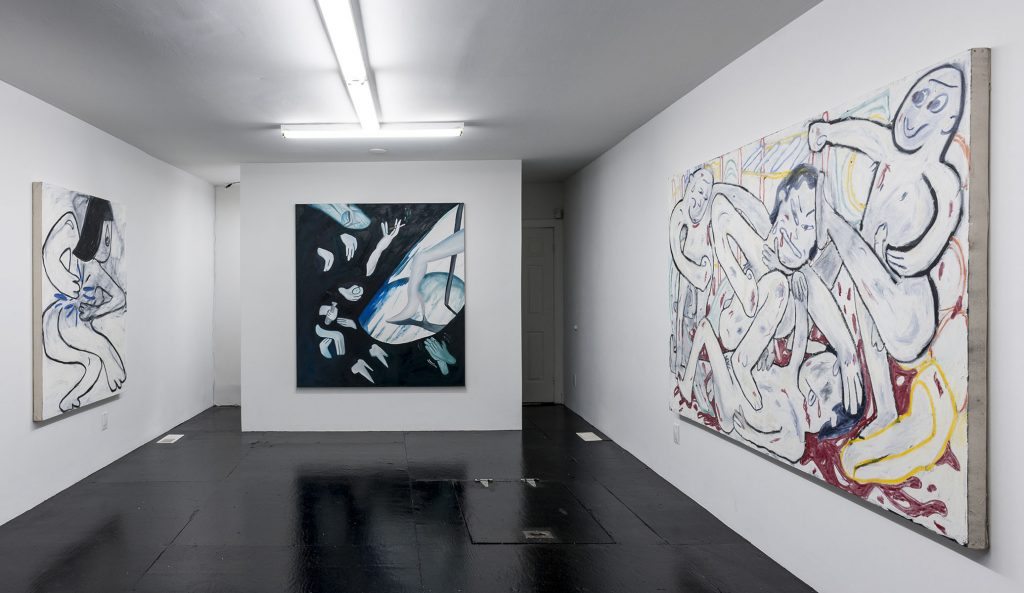
JUNE CULP
Well, I think picking up on the different sects in Baltimore is super important, like you were saying, because you could point to anyone and the answer would be different.
I guess I mean the scene you’re involved in.
Yeah. The importance of the cultural scene here for me has, to an extent, hinged on its autonomy, or its self sufficiency as a wildly dynamic space, as being able to function almost entirely without having to pull from other spaces or communities (like waiting for A Big Band to come to one of the more legit venues). The style has been that other communities would suck in Baltimore stuff, you know, pay $40 a ticket for a Baltimore act and then, here—
—Go to their house.
—Yeah, see them play a $5 whatever show. I mean especially with music, I would see so much of it get sucked into New York or other cultural centers. I feel like the questions that I bring up in [the art] conversation—it seems that because it’s all on the East coast, everything above a certain point has to pass through New York and below a certain point, Miami. But, compare it to the way things have progressed in Europe: maybe it is biennial culture that has made smaller cities there much more apt for being able to support their own art historical lineages.
Absolutely.
When I graduated from college, I didn’t have a computer and the Internet was not developed like it is now. People were using AOL dial up to get online…
—Live journal just invented, right.
I remember there was just this tremendous push, like, if you want to be an artist, you gotta go to New York—otherwise you don’t fucking exist.
And, of course, there are always gonna be people that don’t buy into that, like “Fuck that, I’m gonna stay in Providence.” I was more interested in what New York might have to offer. Iwanted to see my work in a white cube. That, to me, was interesting. I’d only seen my shitty paintings in shitty rooms. So living in New York at that time, my knowledge of the art world was pretty much extremely New York centric. I didn’t know what was happening in Europe or Los Angeles or wherever else—I was in the dark.
In 2006, I met a guy who had been living in LA and he knew all these artists and galleries out there that I had never heard of and it was like somebody lifted up a curtain. In 2008, I moved to Berlin for a period of about nine months. That was an extremely stimulating situation because I was exposed to a whole other world of contemporary arts spaces, like in Germany and even doing a little bit of traveling and seeing interesting spaces in Prague and elsewhere. You know there were all these spaces in out of the way places in little nooks and crannies throughout Europe—that doesn’t really exist in America. If you want to see contemporary art, you basically go to the LES or Chelsea and you walk a couple of blocks and that’s where all the shit is. It’s like spoon feeding you the stuff.
So the point I’m trying to get at—I’m pretty sure it was 2008 when Contemporary Art Daily came on to the Internet scene and that was (and still is) highly influential. And one of the things that I like about it a lot is that it’s not New York centric. So I can visit that website pretty much any day of the week and see an artist I’ve never heard of in a gallery I’ve never heard of in a city I’ve never heard of. That’s amazing. I think that becoming more aware of various artists and galleries in many parts of the world helps keep it interesting.
I would think that it’s going to have an impact on… I guess what I’m trying to say is that, I think way before Freddy got here, I saw artists in Baltimore and other cities like Philadelphia extending their dialogue out to New York. Nudashank in particular, really generated a good amount of visibility for Baltimore and some of its artists. I was impressed to see Springsteen becoming a member of NADA—A small gallery in Baltimore, MD doing NADA with galleries from Zurich and Prague and the world—right on, I thought that was so cool.
So there was that desire (at least in a certain portion of the art scene here) in wanting to engage in a broader conversation. And that was also part of my thinking—I was like, “Cool, I want to be a part of that.” I was curious to see how a smaller community of artists would respond to the work I planned to exhibit.
Yeah.
But, it always comes back to money doesn’t it. People are afraid that rent’s gonna go up and you might have to move to a different neighborhood and, as a result of that, I think people are kind of fearful and opposed to what might come in from the outside. So I think it’s a really strange thing for you to have to navigate, for you guys, as young artists working here. How do you, if you want to engage with a bigger conversation, allow yourself to be open to that, but at the same time, to some extent, protect what you have.
There is that push and pull. Part of me is always urging against globalism because I have all these negative connotations with homogenized culture (which is the way of the world, I guess), but the aspect of seeing the way that Europe is able to have all these non-central centers that are just killing it—
—Yeah.
—That they are able to exchange as equals, and that they are just [different] “cultures,” that is very interesting to me.
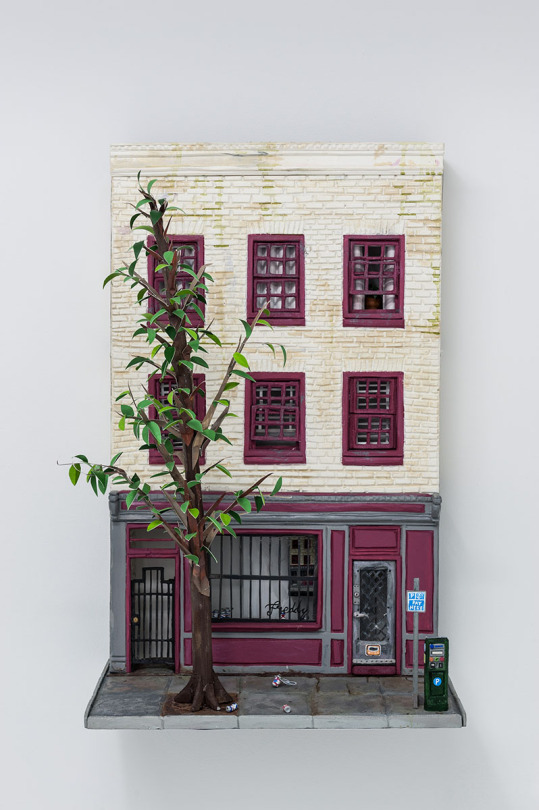
NICHOLAS BUFFON
And maybe that is simply from the historical [and imperial/colonial] power of Western Europe from the past 500 years, where the art scenes had overbearing histories behind them because they were directly supported by a lot of money and resources. You know, patrons commissioning “This or that scenery of our estate and it’s beautiful and we’re painted into it and it shows how rich we are.” Maybe because there is art historical reference within their own cities, they might not have the same need for validation from another place.
There was an interview with the late Mike Kelley that I was watching recently, he was saying how American culture is vehemently anti-intellectual. Which I think is true. And having spent some time in Europe, it’s truly not the case over there.
I think that’s part of it, too.
Photos courtesy of Freddy Gallery. Freddy was a curatorial project that ran from June 2014 through September 2015 at 510 W. Franklin Street, Baltimore, MD 21201